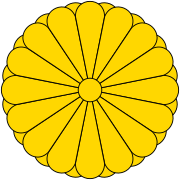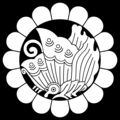Mon (crest)
From Wikipedia, the free encyclopedia
| This article may require cleanup to meet Wikipedia's quality standards. Please improve this article if you can. (February 2008) |
Mon (紋 )(plural mon), also monshō (紋章 ), mondokoro (紋所 ), and kamon (家紋 ), are Japanese heraldic symbols. Mon may refer to any symbol, while kamon and mondokoro refer specifically to family symbols. Mon serve roughly similar functions to badges, crests, and coats of arms in European heraldry.
Contents |
[edit] History
It is thought that mon originated as fabric patterns to be used on clothes in order to distinguish individuals or signify membership in a specific clan or organisation. By the twelfth century, sources give a clear indication that heraldry had been implemented as a distinguishing feature, especially for use in battle. It is seen on flags, tents and equipment.
Like Western heraldry, mon were initially held only by aristocratic families, and were gradually adapted by commoners. On the battlefield, mon served as army standards, even though this usage was not universal and uniquely designed army standards were just as common as mon-based standards. (cf. sashimono, uma-jirushi) Mon were also adapted by various organizations, such as merchant and artisan guilds, temples and shrines, theatre troupes and even criminal gangs. In an illiterate society, they served as useful symbols for recognition.
Japanese traditional formal attire generally displays the mon of the wearer. Commoners without mon often used the mon of their patron or the organization they belonged to. In cases when none of those were available, they sometimes used one of the few mon which were seen as "vulgar", or invented or adapted whatever mon they wished, passing it on to their descendants. It was not uncommon for shops, and therefore shopowners, to develop mon to identify themselves.
Rules regulating the choice and use of mon were somewhat limited, though the selection of mon was generally determined by social customs. It was considered improper to use a mon that was known to be held by someone else, and offensive to use a mon that was held by someone of a high rank. When mon came into conflict, the lower-ranked person sometimes changed their mon to avoid offending their superior. The mon held by the ruling clans of Japan, such as Tokugawa's hollyhock mon and the Emperor's chrysanthemum mon, were legally protected from unauthorized usage.
Occasionally, patron clans granted the use of their mon to their retainers as a reward. Similar to the granting of the patron's surnames, this was considered a very high honour. Alternatively, the patron clan may have added elements of its mon to that of its retainer, or choose a completely different mon for them.

[edit] Design
There are no set rules in the design of a mon. It most commonly consists of a roundel encircling a figure of plant, animal, man-made, natural or celestial objects, all abstracted to various degrees. Religious symbols, geometric shapes and kanji were commonly used as well.
Similar to the blazon in European heraldry, mon are also named by the content of the design, even though there is no set rule for such names. Unlike in European heraldry, however, this "blazon" is not prescriptive - the depiction of a mon does not follow the name - instead the names only serve to describe the mon. The pictorial depictions of the mon are not formalized and small variations of what is supposed to be the same mon can sometimes be seen, but the designs are for the most part standardized through time and tradition.
The degree of variation tolerated differ from mon to mon as well. For example, the paulownia crest with 5-7-5 leaves is reserved for the prime minister, whereas paulownia with fewer leaves could be used by anyone. The imperial chrysanthemum also specifies 16 petals, whereas chrysanthemum with fewer petals are used by other lesser imperial family members.
Japanese heraldry does not have a cadency or quartering system, but it is not uncommon for cadet branches of a family to choose a slightly different mon from the senior branch. The princely families (Shinnōke), for example, each uses a modified chrysanthemum crest as their mon. Mon holders may also combine their mon with that of their patron, benefactor or spouse, sometimes creating increasingly complicated designs.
Mon are essentially monotone; the colour does not constitute part of the design and they may be drawn in any colour.
[edit] Modern usage

Virtually all modern Japanese families have a mon, though modern usage is rare. Many Japanese may no longer recognize their own family's mon. On occasions when the use of mon is required, one can try to look it up in the temple registries of their ancestral hometown or consult one of the many genealogical publications available. Professional wedding planners, undertakers and other ritual masters may also offer guidance on finding the proper mon.
Mon can still be seen widely on stores and shops engaged in traditional crafts and specialities. They are favoured by sushi restaurants which often incorporate a mon into their logos, while mon designs can be seen on the ceramic roof tiles of older houses. Mon designs also frequently appear on senbei, sake, tofu, and other packaging for foodstuffs to lend them an air of elegance and refinement. The paulownia mon appears on the obverse side of the 500 yen coin.
Items symbolising family crafts, arts or professions were often chosen as a mon. A fan design might be chosen by a geisha. A woman may still wear her maiden mon if she wishes and pass them on to her daughters and does not have to adopt her husband's or father's mon.
Mon add formality to a kimono. A kimono may have one or three or five mon. The mon themselves can be more or less formal; more formal kimono display more numerous mon, and frequently in a manner so as to make them stand out more. This may help dress up or dress down the formality of a kimono at the wearer's discretion. In the dress of the ruling class, the mon could be found on the kimono on both sides of the chest, on both sleeves, and in the middle of the back. On the armour, it could be found on the kabuto (helmet), on the do (cuirass), flags, and various other places. Mon could also be found on coffers, tents, fans, and many other items of importance.
As in the past, modern mon are not regulated by any law, with the exception of the imperial chrysanthemum, which doubles as the national emblem, and the paulownia, which is the mon of the office of prime minister and also serves as the emblem of the cabinet and the government. Some local governments, associations and businesses may use mon as their logo or trademark, and thus enjoy all the protection as such, but otherwise mon are not recognized by law. One of the best known examples of a corporate logo in the form of a mon is the logo for Mitsubishi, a name meaning "three water chestnuts", which are represented as rhombuses.[1]
[edit] List of representative kamon
|
This paulownia flower pattern (go-shichi-no-kiri) is the symbol of the Office of the Prime Minister of Japan |
Agehanochō, the butterfly crest of the Taira clan |
||
|
Maruni Mitsu Aoi (Mitsuba aoi), the hollyhock crest of the Tokugawa clan |
|||
|
Mitsu uroko, or 3 fish scale crest of Hōjō clan |
Mitsu Irekomasu, the crest of the Ichikawa family of kabuki actors |
||
|
Yotsu Hanabishi, the crest of the Matsumoto family of kabuki actors |
- Chigai: crossed, daki: holding, go: five, maruni: a circle and, mitsu and mittu: three, mukai: faced, yotsu and yottu: four.
- Abeseimeiban (阿部清明判), Ichikawa, Sakō clans
- Abekezeni (阿部家銭)
- Agehanochō (揚羽蝶), swallowtail butterfly, Nishinotōin clan
- Aizu mitsu aoi (会津三葵), wild ginger (Asarum caulescens) leaves, Aizu Matsudaira clan
- Arimake kara hana (有馬家唐花)
- Arimoji (有文字)
- Chigai bishi (違菱)
- Chigai daikon (違大根)
- Chigai kine (違杵)
- Chigai kuginuki (違釘抜)
- Chigai masakari (違鉞)
- Chigai takanoha (違鷹羽),
- Chigai yabane (違矢羽)
- Chūwani chigaikama (中輪に違鎌)
- Chūwani gosannokiri (中輪に五三桐)
- Chūwani narabitakanoha (中輪に並鷹羽)
- Daki gyōyō (抱杏葉), Ōtomo, Tachibana clans
- Daki kajinoha (抱梶葉)
- Daki kashira (抱柏)
- Daki myōga (抱茗荷)
- Daki Omodaka (抱面高)
- Daki ine (抱稲)
- Daki kajinoha (抱梶葉)
- Daki kashiwa (抱柏)
- Daki omodaka (抱面高)
- Eirakusen (永楽銭), Oda, Mizuno, Sengoku clans
- Futowani masakari (太輪に鉞)
- Gaku (額) Koide clan
- Genji kōzu (源氏香図)
- Gion mamori (祗園守)
- Gion mamoriku-zushi (祗園守崩し)
- Gosan no kiri (五三桐), Toyotomi, Hosokawa clans
- Gohon bone ōgi (五本骨扇), Satake, Ōkōchi clans
- Gomaisasa (五枚笹)
- Goshichi no kiri (五七桐)
- Gyōyō botan (杏葉牡丹), Hayashi, Sayama, Kōda, Shigeta clans
- Hanabishi (花菱)
- Hanakage kyōyōbotan (花陰杏葉牡丹)
- Hanatsuki mitsuaoi (花付き三つ葵)
- Hidari futatsu domoe (左二巴)
- Hidari midori (左三ツ巴), Saionji, Utsunomiya, Kii, Kamachi, Okabe clans
- Hinomaru ōgi (日の丸扇)
- Hirai zutsu (平井筒)
- Hiraki kasa (開き傘)
- Hishimochi (菱持)
- Hitotsu tabanenoshi (一束熨斗)
- Hitotsu tsurumyōganome (一蔓茗荷丸)
- Hiyokuzuru (比翼鶴), Kamachi clan
- Hōjōke uroko (北条家鱗)
- Hondake tachiaoi (本多家立葵)
- Honmoji (本文字), Honda clan
- Hosowani nozoki kajinoha (細輪に覗き梶葉)
- Ichimonji (一文字), Yamanouchi, Nasu clans
- Ichimonji jimitsuboshi(一文字三星), Mōri clan
- Igeta (井桁)
- Igetani mokkō (井桁に木瓜)
- Ikari (碇)
- Ine no maru (稲の丸)
- Injūchō (因州蝶), Ikeda clan
- Iori (庵)
- Ippon sugi (一本杉)
- Ishimochi (石餅), Tōyama, Itami clans
- Itōke fuji (伊藤家藤)
- Itowani kawarikochō (糸輪に変り胡蝶)
- Itowani uchiwa (糸輪に団扇)
- Itsutsu rindōguruma (五ツ龍胆), Kuga clan
- Itsutsu warimanji (五割万字), Yokoyama, Hachisuka clans
- Janome (蛇の目)
- Jinuki eirakusen
- Jūjikurusu (十字久留子)
- Jūrokuben yae omotegiku (十六弁八重表菊) - Emperor of Japan
- Jūrokuyou uragiku (十六葉裏菊), Hirohatake clan
- Jūroku uragiku (十六裏菊), Nashimoto-no-miya Princely House
- Jūshiben hitoe uragiku (十四弁一重裏菊)
- Kagekuyō (陰九曜)
- Kageman jimaru (陰万字丸)
- Kagetsuta (陰蔦)
- Kagome (籠目)
- Kaji (卦字), Kosaka, Miki clans
- Kakitsu batabishi (杜若菱), Kazanin clan
- Kama (鎌)
- Kana wakuzushi (金輪崩し)
- Kan-ei Tsūhō (寛永通宝), Fukushima clan
- Kanibami (酢漿草), Nitta, Sakai, Hirano, Hida, Nakazawa, Taga, Akada, Hirao clans
- Karabishibana (唐菱花)
- Karahana (唐花)
- Kasa (傘)
- Kasa (笠)
- Kasane hanagata genjiguruma (重ね花形源氏車)
- Kasane masu (重ね枡)
- Kashira awasemitsu kasa (頭合三笠)
- Kawari kikusui (変り菊水)
- Kawari uchiwa (変り羽団扇)
- Kichimoji (吉文字), Mōri, Nagai clans
- Kikkō (亀甲)
- Kikkōni hanabishi (亀甲に花菱)
- Kiku fusen ryō (菊浮線綾)
- Kikusui (菊水), Kusunoki clan
- Kikyō (桔梗), Toki clan
- Kiriguruma (桐車)
- Kiyobu chō (きよぶ 蝶)
- Kochō (胡蝶)
- Komochi kikkō (子持亀甲)
- Konoe botan (近衛牡丹), Konoe family
- Kuginuki (釘抜)
- Kujōke fuji (九条家藤), Kujō family
- Kumihiraizutsu (組平井筒)
- Kurodake tachibana (黒田家橘)
- Kutsuwa (轡)
- Kuyō (九曜), Hosokawa, Sakuma clans
- Manji (卍)
- Maruni agehanochō (丸に揚羽蝶), Ikeda, Hiramatsu clans
- Maruni chidori (丸に千鳥)
- Maruni chigai chōji (丸に違丁字)
- Maruni chigai takanoha (丸に違鷹羽), Asano, Kikuchi, Handa clans, Kubo
- Maruni chigai ya (丸に違矢)
- Maruni dakikashiwa (丸に抱き柏)
- Maruni dakimyōga (丸に抱茗荷)
- Maruni futatsu biki (丸に二引), Akamatsu, Ashikaga clans
- Maruni hanaken bishi (丸に花剣菱)
- Maruni hanare kenkatabami (丸に離れ剣片喰), Hirano clan
- Maruni hidari mitsu domoe (丸に左三巴),Matsumata clan
- Maruni hidari sangaimatsu (丸に左三階松) Heishi clan Heike
- Maruni hitotsu kine (丸に一杵)
- Maruni hitotsu uroko (丸に一鱗)
- Maruni ipponsugi (丸に一本杉)
- Maruni jūnoji (丸に十の字) - Shimazu, Ijuin clans
- Maruni katabami (丸に片喰), Reizei, Irie clans
- Maruni kawari iori (丸に変り庵)
- Maruni kawari sangaibishi (丸に変り三蓋菱)
- Maruni kenkatabami (丸に剣片喰), Hirano clan
- Maruni kikyō (丸に桔梗), Oka, Nakamura clans
- Maruni kumai zasa (丸に九枚笹), Kanamitsu clan
- Maruni masu (丸に枡)
- Maruni mitsu aoi (丸に三葵) aka. Mitsuba aoi (三葉葵) - Tokugawa, Matsudaira clans
- Maruni mitsu gashiwa (丸に三柏), Yamanouchi, Makino clans
- Maruni mitsu ōgi (丸に三ツ扇)
- Maruni narabihiiragi (丸に並柊)
- Maruni sumitate yotsume (丸に隅立四目), Shinozuka clan
- Maruni nitsuta (丸に蔦)
- Maruni tachibana (丸に橘)
- Maruni tekoku ginukibishi (丸に梃子釘抜菱)
- Maruni tobima izuru (丸に飛び舞鶴)
- Maruni yotsu ishi (丸に四石)
- Maruno uchini mitsuhikiryō (丸の内に三引両)
- Masu (枡)
- Matsu kawabishi (松皮菱)
- Migi mitsudomoe (右三巴), Saionji, Utsunomiya clans
- Mika zuki (三日月), Nonaka, Ōhara clans
- Mitoke mitsu aoi (水戸家三葵)
- Mitsu bikiryō (三引両)
- Mitsu gashiwa (三柏)
- Mitsu hiōgi (三檜扇)
- Mitsu ichō (三銀杏)
- Mitsu ishi (三石)
- Mitsu kaede (三楓), Imadegawa clan
- Mitsu ōgi (三ツ扇), Matsudaira clan (Ōkōchi branch)
- Mitsu oi hiiragi (三追柊)
- Mitsu uroko (三つ鱗), Hōjō clan
- Mitsu warinadeshiko (三割撫子)
- Mitsugumi tachibana (三ツ組橘)
- Mitsumori janome (三盛蛇の目)
- Mitsuya (三矢)
- Mittsu gasa (三傘)
- Mittsu irekomasu (三入子枡), Ichikawa family
- Mittsu kanawa (三金輪)
- Mittsu karigane (三雁金), Hanabusa, Shibata clans
- Mittsu naname karigane (三斜雁金)
- Mittsu sasarindō (三笹竜胆)
- Mittsu tachi jikuchigai ichō (三立軸違銀杏)
- Mochi aikutsuwa (持合轡)
- Mokkō (木瓜), Oda clan
- Mokkō hanabishi fusen-aya (木瓜花菱浮線綾), Tokudaiji clan
- Mukai bato (対鳩), Yamamoto, Kojima clans
- Mukai nami (対波), Aoyama, Oguri clans
- Musubi karigane (結雁金)
- Musubi mitsugashiwa (結三柏)
- Mutsuya guruma (六矢車), Hattori, Yabe clans
- Nabeshima kebotan (鍋島家牡丹)
- Nabeshima kehiashi (鍋島家日足), Fukao, Nabeshima clans
- Nadeshiko (撫子)
- Naitōkeuchiwa (内藤家団扇) ū
- Nakagawake kurusu (中川家久留子)
- Nakakagemitsudomoe (中陰三巴)
- Nakakagesagarifuji (中陰下藤)
- Namiwani kagechidori (波輪に陰千鳥)
- Nejikikyō (捻桔梗)
- Nejimukō ume (捻向梅)
- Nihachigaku (二八額), Koide clan
- Nihonsugi (二本杉)
- Nijōkefuji (二条家藤), Nijō clan
- Nobori fuji (昇り藤)
- Ojikini-sanmoji (折敷に三文字), Kōno, Hitotsuyanagi clans
- Omodaga (沢瀉)
- Ōnakaguro (大中黒) - Nitta Yoshisada
- Onizuta (鬼蔦)
- Roku monsen (六文銭), Sanada clan
- Sagarifuji (下藤), Kujō, Naitō clans
- Sakura (桜)
- Sakura fusenryō (桜浮線両)
- Sanadake zeni (真田家銭), Sanada clan
- Sanbonsugi (三本杉)
- Sangaibishi (三蓋菱), Ogasawara clan
- Sanmonsen (三文銭), Watanabe clan
- Sasarindō (笹竜胆)
- Sendai izasa (仙台笹), Date clan
- Shimazu jūmonji (島津十文字), Shimazu clan
- Soroi futatsu hikiryō (揃い二つ引き両)
- Sumiatate yotsume (隅立四目), Sasaki, Kyōgoku clans
- Sumikiri hanabishi (隅切り花菱)
- Tachi aoibishi (立葵菱)
- Tachibana (橘)
- Tachi kajinoha (立梶葉)
- Tachi omodaka (立面高)
- Tachiaoibishi (立葵菱)
- Tachibotan (立牡丹)
- Tachika jinoha (立梶葉)
- Taikō giri (太閤桐)
- Taikyokuzu (対極図), Yasuoka clan
- Takanoha (鷹の羽), Falcon Feathers (鷹の羽 Takanoha) is the crest of Kubo (久保 Kubo) Family.
- Takeda bishi (武田菱), Takeda, Baba clans
- Tooyamake fuji (遠山家藤)
- Tsurunomaru (鶴の丸), Hino, Yanagiwara clans
- Tsuta (蔦), Kiga clan
- Uchiwazasa (団扇笹)
- Ume (梅)
- Umebochi (梅鉢), Maeda, Sugawara, Takatsuji clans
- Uraki kubishi (裏菊菱)
- Uranamisen (裏波銭)
- Wari daikon (割大根)
- Waribishi (割菱), Takeda, Baba, Imai clans
- Yagyū gasa (柳生笠), Yagyū clan
- Yama togizakura (大和桜)
- Yamabishi (山菱)
- Yamani kasumi (山に霞), Yoshida, Ikehara clans
- Yanagi sawanabishi (柳沢花菱)
- Yattsu chōji (八丁字)
- Yoko mokkō (横木瓜)
- Yonezawazasa (米沢笹)
- Yotsu hanabishi (四ツ花菱), Matsumoto family
- Yotsume yui (四つ目結)), Sasaki, Kyōgoku clans
- Yotsume mon (四つ目紋)
- Yottsu ikari (四碇)
- Yottsu ishi (四石)
- Yottsu matsukawabishi (四松皮菱)
- Yuki (雪)
[edit] See also
[edit] References to popular media
Modern designs, such as Nintendo's Legend of Zelda triforce, resemble Japanese family crests. (Mitsu-uroko)
[edit] References
- ^ "The Mitsubishi Mark". Mitsubishi.com. 2008. http://www.mitsubishi.com/e/group/mark.html. Accessed 10 August 2008.
[edit] External links
| Wikimedia Commons has media related to: Heraldry of Japan |
- Website offering free EPS files of kamon, sorted by category (En)(Ja)
- Hidaka Family Emblems: A latern-maker's website that features illustrations of many kamon
- The Japan Society of San Diego and Tijuana's page on kamon
- A short flash presentation showing lots of kamon (click on the center (再生) to start)
|
|||||||||||





























